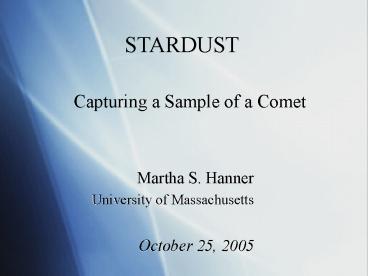Capturing a Sample of a Comet
1 / 44
Title: Capturing a Sample of a Comet
1
Capturing a Sample of a Comet
STARDUST
- Martha S. Hanner
- University of Massachusetts
- October 25, 2005
2
Comet Hale-Bopp
W. Pachoika 4/5/97
3
ion tail
dust tail
4
Thermal Emission from Comet P/Enckes dust
ISO infrared view of Comet P/Enckes dust
Reach et al.
5
Parts of an Active Comet
- Nucleus 1 -- 10 km
- Coma 103 -- few x 104 km
- Ion Tail 106 km
- Dust Tail (small grains) 107 km
- Dust Trail (mm-cm grains)
- spread along orbit up to few x 107 km, can
eventually spread around orbit
6
(No Transcript)
7
An Icy Conglomerate Nucleus
In 1950, Fred Whipple showed that comet activity
can be explained by sublimation of water ice
from an icy conglomerate nucleus a few km in
size. The sublimation rate can be computed as a
function of temperature.
8
How can we observe a comet nucleus?
- 1. Observe when inactive at large r
- Measured total brightness assumed albedo
yields nucleus size - Measured light curve gives nucleus shape
- gt comet will be faint
- is it really inactive?
9
How can we observe a comet nucleus?
- Observe at high spatial resolution
- Subtract coma contribution from central pixels
- Measured brightness assumed albedo yields
nucleus size - gt Has been done successfully with HST
- (Lamy et al.) uncertainty is significant
10
How can we observe a comet nucleus?
- 3. Observe thermal emission in the infrared
- Measure thermal SED and fit with blackbody
emission - Use measured flux and best-fit blackbody to
derive radius - f? ? R2 ? B? (T) / ?2
- High T indicates comet is not ice-covered
- gt thermal emission from dust must be low
- for this method to work
11
Tokunaga Hanner 1985
12
Periodic Comet Halley, 1986
- Our first look at a comet nucleus
- (Comet Halley will return in 2061)
Giotto
13
Comet P/Halley
Giotto HMC
14
Comet West
Comet West
15
Where does cometary dust originate?
16
8-13 micron spectrum, Hale-Bopp Halley
Thermal emission from small silicate grains in
comets
Hanner et al. 1999
17
Hale-Bopp ISO version1
ISO SWS
Crovisier et al.2000
18
Origin of Cometary Silicates
- Crystalline olivine and pyroxene condensed at
high T, most likely in the inner solar nebula - Glassy silicates were not subjected to high
temperature, may be ancient interstellar grains
19
(No Transcript)
20
GEMS Glass with Embedded Metal and Sulfides
Bradley et al. 2004
21
GEMS Are they interstellar grains?
- Heavily irradiated - eroded rims, abundance
gradients, FeNi metal - Embedded in high D/H organic refractory
- FeNi beads gt grain alignment in galactic
magnetic field - IS silicate feature
- Size 0.1 - 0.5 ?m
22
STARDUST Comet Sample Return Mission
- PI Donald Brownlee, Univ. Washington
- Deputy PI Peter Tsou, JPL
- Launch February 7, 1999
- Encounter January 2, 2004
- Earth Return January 15, 2006
23
The Importance of Sample Return Missions
Science is done on the ground Instrumentation
is state-of-the-art and more Ultimate in
precision sensitivity Not limited by mass,
power, cost or reliability Results can be
confirmed by several methods Instruments can be
calibrated Analysis is iterative not limited
by pre-conceived ideas Samples - a resource for
present and future study
24
Aerogel - Peter Tsou
Dr. Peter Tsou with aerogel
25
Have a Great Idea
- Be Persistent for a
- Decade!
26
Aerogel
Aerogel
27
Test of Particle Capture in Aerogel
50-100 ?m FeS particles V 6 km/s
28
Stardust Spacecraft
Artists view
29
(No Transcript)
30
(No Transcript)
31
Stardust launch, February 7, 1999
32
Stardust launch
Comet 81P/Wild 2
K. Meech
33
7 years - 3 loops around the Sun
Earth gravity Assist 1/15/2001
Earth return 1/15/2006
Loop 1
Loops 2 3
Launch 2/7/99
--
Interstellar dust Collection periods
Wild 2 encounter 1/2/2004
direction of interstellar flux
34
Encounter with Comet 81P/Wild 2
- January 2, 2004
- 98 days post-perihelion
- Heliocentric distance 1.86 AU
- Geocentric distance 2.6 AU
- Closest approach 236 km
- Encounter speed 6 km/s
35
72 encounter Images Full range of phase angles
( 70o - 3o - 110o) Alternate 10
100ms exposures
36
Comet P/Wild 2
Stardust
3.3 x 4 x 5.5 km
37
Wild 2 nucleus
Phobos
23 km diameter
38
Flat-floor crater - 140m deep
stereo
39
Scarps Cliffs imply crust with some strength
40
Wild 2 image superimposed on jets
P/Wild 2 nucleus
Nucleus image superimposed on image of jets
41
Stardust Sample Return
- The first sample to be returned directly from
a comet will reach Earth on - January 15, 2006
42
Comet Sample Return
- Dust Composition
- What is the elemental, chemical, and
mineralogical composition of comets at the
submicron scale? - Are isotopic anomalies present?
- Are both high and low temperature condensates
present? - Are forsterite and enstatite present in the
abundance inferred from spectra of Oort cloud
comets? - Are refractory grains rich in Al, Ti, Ca
present?
43
Comet Sample Return
- Carbon
- What is the nature of the carbonaceous
material? - What organic compounds are present?
- Are D/H hot spots present in organic
carbon? - Are there organic refractory mantles on
silicate grains?
44
Comet Sample Return
- Comparison with Meteorites
- How does the composition compare with
primitive - meteorites?
- Are the comet grains similar to chondritic
porous IDPs? - What is the state of water in cometary
grains? Are hydrated minerals present?































